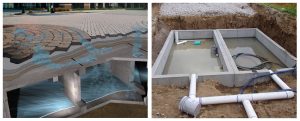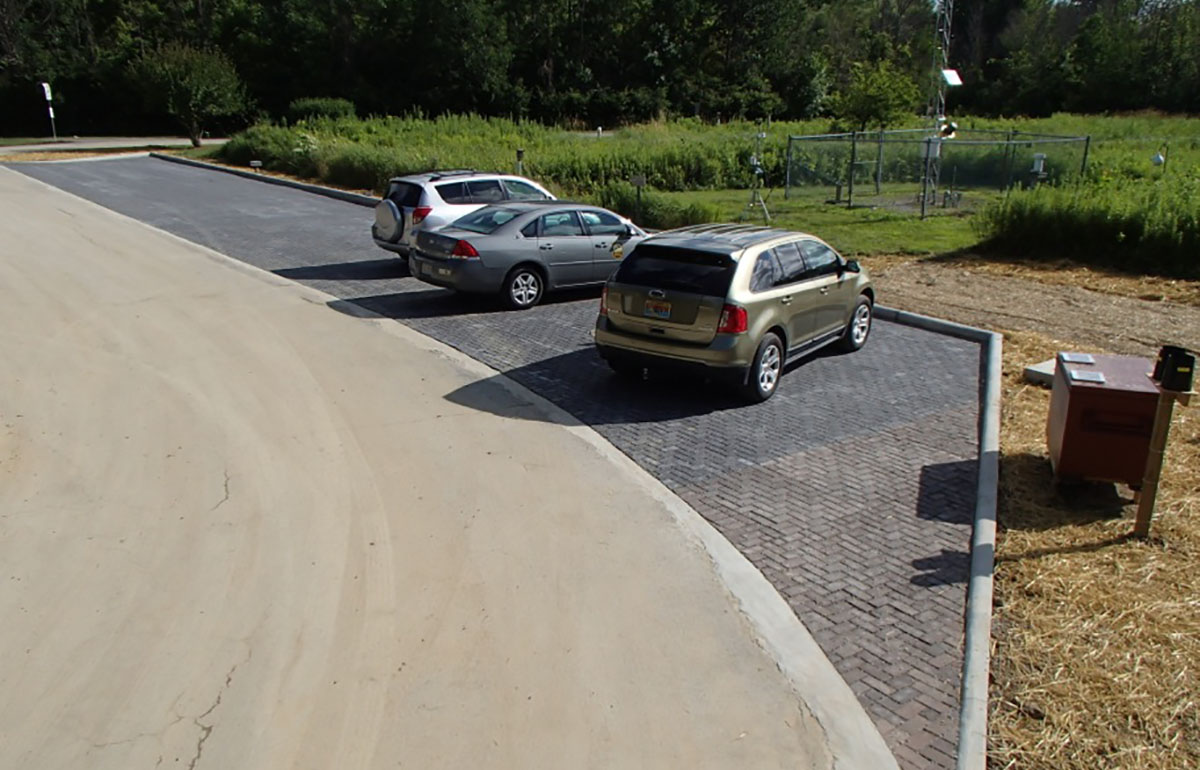Old Woman Creek Estuarine
Belgard® Permeable Pavers and Precast Vault Used for Rainwater Harvesting in Research Project
Background
In 2014-2015, Belgard® ’s Permeable Interlocking Concrete Pavements (PICP) product was chosen as a feature in one of numerous study sites by the Ohio Department of Natural Resources. Through various research sites, the agency sought to fill knowledge gaps and improve stormwater management. The goal was to find systems that better manage stormwater and, in the case of PICP, observe how the material can reduce runoff, improve water quality and mitigate peak flow. Ultimately, the study was designed to be a technical and educational resource for stormwater professionals and others seeking to learn about the performance of LID stormwater technologies in Ohio.
So, why permeable interlocking concrete pavements? Stormwater runoff from impervious surfaces is a major contributor to surface water impairment. In addition, improperly managed stormwater can result in downstream hydrologic impacts, such as erosion along existing drainage courses, flooding of adjacent low lying areas, and sedimentation/contamination of receiving waters (including wetlands and estuaries, lakes and rivers, and/or surface water supplies of drinking water). Stormwater control measures (SCMs) are increasingly being used as part of a Low Impact Development strategy (LID). Permeable pavement is one of the standard bearers for LID, and is utilized for both hydrologic and water quality improvement. Belgard’s Permeable Interlocking Concrete Pavements (PICP) are fundamentally large-scale infiltration galleries with a drivable surface course over top. The open-graded base and subbase aggregates have approximately 32% and 40% open space respectively, providing for temporary water storage. Being the same aggregates used for railway tracks, they are more than capable of supporting vehicular loads. Use of PICP on various plaza and boulevard applications can add to the aesthetic look of a project, eliminate the need for traditional stormwater conveyance works, improve groundwater quality and prevent downstream hydrologic impacts
The Challenge
Located in Huron, Ohio, on the south-central shore of Lake Erie, Old Woman Creek National Estuarine Research Reserve (OWC NERR) is part of a network of 28 coastal reserves connected nationally through the National Oceanic and Atmospheric Administration (NOAA) to address state and regional coastal management needs through research, education, and stewardship. The National Estuarine Research Reserve System uses its network of living laboratories to help understand and find solutions to crucial issues facing America’s coastal communities. As a research center, the Reserve has incorporated many green building materials and construction techniques over the last decade. Until June 2014, the parking lot area of the Reserve consisted of just over 16,000 SF of impervious asphalt and approximately 2,900 SF of pervious grass pave system. The grass pave system stopped functioning properly due to poor water infiltration likely caused by compaction of the underlying soil or gravel. Parking lot runoff contributed to slope erosion near one of the trails and excess sediment loading into the estuary.
The Solution
In this case study, the existing parking lot was retrofitted with permeable interlocking concrete pavers. The system had a 1.7:1 loading ratio, with 5,000 SF of impermeable asphalt draining onto the 2,900 SF of PICPs. From the bottom to the top of the cross-section, the permeable pavement aggregate layers include 18- 22 inches of #2 stone, four inches of #57 stone and two inches of #89 stone. The six-inch underdrain was raised three inches off the subgrade to provide an internal water storage zone and promote exfiltration. The final design also incorporated a rainwater harvesting system consisting of two concrete StormCapture cisterns, each 3’ x 8’ x 16’ (with a 210 cubic foot capacity) and hydraulically connected with three booted four-inch PVC pipes. These cisterns were placed within the footprint of the PICP system, reducing the effective soil area beneath the PICP that could exfiltrate stormwater to 2,646 SF. The cisterns were covered with 1.5- foot of heavy clay soil and compacted to 95% Proctor density. The aggregate layers for the PICP extend across the top of the compacted clay. The system was designed so that the PICP underdrain flow would be conveyed to a nearby catch basin and then to the StormCapture cisterns. When the cisterns were full, overflow was expected to be channeled through a pipe into a rocklined outlet located in the nearby forest.
Monitoring began in July 2014. The Research Reserve featured a water chemistry lab, which enabled personnel to complete most of the water quality analysis quickly after a rain event. Water quality sampling occurred at three locations on site: a sampling trough at the end of the asphalt parking lot, the PICP underdrain, and the cistern’s spigot (i.e. point of use). Control samples from the asphalt were rainfall-paced composite, underdrain samples were flow paced composite and spigot samples were grab sample.
The Result
During the four-month monitoring period in 2014, a total of 22 rainfall events occurred. Water was transmitted from the aggregate beneath the pavers, through the backfilled soil on top of the cisterns and then into the cisterns without first draining though the underdrain. The median drawdown rate from the cistern (0.068 in/ hr.) was higher than the drawdown rates from the two wells in the permeable pavement aggregate(0.0002 in/ hr.), suggesting that a more permeable lens in the soil exists at deeper depths at the Old Woman Creek site. Seven rainfall events were sampled for water quality. Effluent concentrations for TKN, TN, TP, and TSS were 0.55, 1.28, 0.06, and 5 mg/L, respectively. This resulted in efficiency ratios between 0.38 and 0.99 for nutrients, sediment, and turbidity. TSS removal rate and turbidity reduction levels exceeded 95%. Heavy metals, nitrogen, total phosphorus and sediment concentrations were lower at the spigot than from the parking lot, which reflects a good capture rate retained within the PICP system. As evidenced by the filling of the cisterns, water was drained off the asphalt and moved to the PICP area for filtration. In terms of treating rainwater, the study states: The results suggest that permeable pavement may be a proper pretreatment for rainwater harvesting through reduction of gross solids, sediment, nutrients, and metals. This will provide cleaner water to the end user, and reduce the frequency of maintenance for water filtration devices such as grit filters.
“Overall, we’re very happy we discovered that the PICP system works well in tight clay soil like we have all over the northern Ohio area, and we’ve been able to create a parking lot to meet our infiltration needs,” said Frank Lopez, Manager of Old Woman Creek NERR. “It’s a win-win.”



